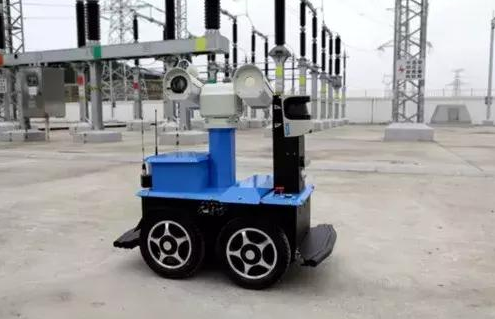Development status of China's intelligent inspection robots and inventory of major enterprises
First, China's high-risk industry "machine substitution" space is very large
China has incorporated robotics and smart manufacturing into the priority areas of national science and technology innovation. China's high-risk industries refer to industries with large risks and high risk factors. “Machine Substitution” completes high-risk work and helps companies reduce costs.
The “13th Five-Year Plan” proposes to strengthen the prevention and control of occupational disease hazards through technological innovation. The 2015 edition of the “Catalogue of Occupational Disease Hazard Factors” published by the four ministries and commissions has increased the original 133 hazard factors to 454. Enterprises face more and more strict occupational disease prevention and control regulations, and they must invest more costs to ensure the safety of employees. "Machine substitution", the application of robots can improve production efficiency, reduce production costs, improve product technology content, and expand the competitiveness of enterprises.
In China's emergence as the world's largest industrial robot market, the "invasion" of high-risk industries such as electricity is inevitable. As the supply of labor market decreases, some high-risk industries face the reality of labor shortage. This may be another driving factor for robots to “go on the job” very quickly.
Second, the substation "call" inspection
As we all know, power system security plays an irreplaceable role in the development of the national economy. Any accident in any link may bring a chain reaction, which will cause large-scale power outages, personal injury and death, damage to the main equipment and even the collapse of the whole network. Catastrophic accident. As a key node connecting the backbone network and the distribution network, how to ensure its normal operation is directly related to the stability and security of the entire power system. In order to ensure real-time monitoring of the main equipment operating status of main transformers, busbars, switches, etc. in the substation, it is necessary to inspect and maintain the substation.
Traditional substation monitoring and inspection mainly through manual means, through the human senses to make a simple qualitative judgment of the equipment, mainly through the methods of watching, touching, listening, sniffing and so on.
However, there are many shortcomings in manual inspections. Traditional manual inspection methods have the disadvantages of high labor intensity, low work efficiency, scattered detection quality, and single means. Manually detected data cannot be accurately and timely accessed into the management information system. Moreover, with the promotion of the unattended mode, the patrol workload is getting larger and larger, and the inspection rate and timeliness cannot be guaranteed. In addition, under geographical conditions such as plateau, oxygen deficiency, cold, or severe weather conditions, manual inspections still have a large safety risk and lack effective means of inspection. In bad weather such as wind, fog, ice, hail, thunderstorms, etc., it is impossible to conduct inspections in time. Therefore, the traditional substation inspection method urgently needs a new "successor".
In order to meet the ever-increasing requirements for power supply quality, a more flexible and practical substation robot patrol system can be applied. The substation equipment inspection robot system conducts inspections of outdoor high-voltage equipment in an unattended or low-powered substation in an autonomous or remote-controlled manner, and can timely detect abnormalities such as defects in power equipment and suspension of foreign objects, and automatically alarm or advance Set up a fault handling. It operates flexibly and freely, and truly plays a role in reducing staff and increasing efficiency, and can accelerate the unattended process of the substation faster.

Third, the domestic market demand for inspection robots
According to the announcement of Yijiahe, the number of substations nationwide is over 20,000, and it is expected to reach 30,000 in 2020. According to the State Grid and China Southern Power Grid planning, the intelligent transformation rate of substation will reach 100%. If the annual 10% progress, the annual demand for outdoor robots in the next five years will be 2000-3000 units.
According to the company's announcement, there are about 30,000 prefecture-level power stations in 297 prefecture-level cities nationwide. According to the “Distribution Network Construction and Transformation Action Plan (2015-2020)”, the domestic distribution automation coverage rate will reach 90% in 2020. It is estimated that the annual demand for domestic indoor robots will exceed 10,000 units in the next five years.
Since 2013, the State Grid has been bidding for the first inspection of substation inspection robots, and the inspection robot market has entered a comprehensive promotion stage. From 2013 to 2015, the number of collections of intelligent inspection robots of substation for the State Grid was 100, 280, and 430, respectively. By 2016, about 1,000 units have been put into operation, and the market scale has grown rapidly. According to this speed, Huatai Securities estimates that the total domestic demand for patrol robots in the period of 2018-2020 is about 47.7 billion yuan, with an average annual demand of about 15.9 billion, corresponding to 9,000 substation inspection robots, 7.2 billion market space, and inspection of substations. There are 81,000 robots with a market space of 40.5 billion yuan.

Taking Jiangsu Pioneer Pioneer as an example, the penetration rate of indoor inspection robots in distribution stations is only about 10%, and the penetration rate of outdoor inspection robots is only about 3%. In the “13th Five-Year Plan” special power plan of Jiangsu Province, by 2020, the total number of intelligent inspection robots will exceed 5,000, and the future will be broad.
















 RCCN WeChat QrCode
RCCN WeChat QrCode Mobile WebSite
Mobile WebSite